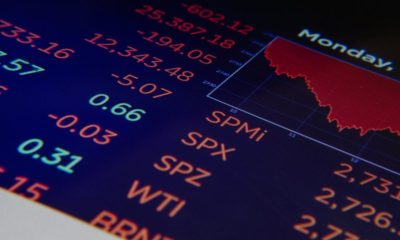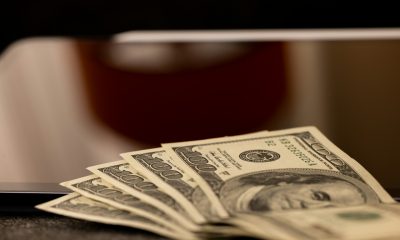Business
Peak Inflation Is Not the Issue
The intractable inflation seen in the June CPI print isn’t all about some aberrant spike in food and energy prices. Core CPI (ex food and energy) spiked 0.7% m/m, which is a faster rate than the previous month and was higher by 5.9% from the previous year. And, if you want to understand why consumer confidence is so dour, real hourly earnings decreased 3.6% year over year.

The reality of record-high inflation combined with a hawkish monetary policy is slowing the economy sharply and has led to the current U.S. recession—two back-to-back quarters of negative growth. The economic contraction should soon cause inflation to roll over along with bond yields; but that isn’t necessarily indicative of a new bull market. It is much the same process that occurred leading up to the Global Financial Crisis of 2008.
The major difference is that the level of inflation today is much greater than it was 15 years ago–a white-hot 9.1% for June of 2022, which is actually close to 20% if calculated using the same method back in 1980. That level is much greater than the 4.1% in December of 2007. Inflation may be peaking, but it is peaking at over 4.5x greater than the Fed’s target. This means the FOMC will find it very difficult to give up its inflation fight anytime soon. It would be a different story if the Effective Fed Funds Rate was trading close to the Fed’s neutral range, which Mr. Powell believes is close to 2.5%, not the 1.58% seen today. With CPI at 9.1% and its balance sheet at $8.9 trillion, it is untenable for the Fed to remain stimulative to inflation. Indeed, the FOMC wants the interbank lending rate at 3.5-4.0% by the end of 2022.
Nevertheless, the apogee of CPI is probably here; and a falling 2nd derivative of inflation would be great news for the stock market as long as it didn’t also come along with crashing economic growth. And, if the Fed were to slow down hiking rates, or even stop hiking completely, it would not necessarily be a panacea. During the last three recessions, the Fed had to significantly reduce interest rates and/or undergo Quantitative Easing programs to boost the market. Even after taking on such monetary endeavors, the results were not immediately manifest. During the Dot.com recession, the Fed had to reduce borrowing costs by 475 bps before the market bottomed—that process took nearly two years. During the GFC, the Fed took rates down by 525 bps before stocks found support—that process took a year and a half and was aided by a massive QE program. And even during the outbreak of the COVID-19 pandemic, it took the start of unlimited QE and a return to ZIRP before markets turned around. Newsflash for Wall Street: Monetary policy works with a rather long lag.
Can one honestly compare today’s situation with the debt levels and asset bubbles in existence leading up to the Tech and Real Estate bubbles? No, the current situation is actually much worse.
Peak Inflation? Maybe…but That’s Not the Issue
The intractable inflation seen in the June CPI print isn’t all about some aberrant spike in food and energy prices. Core CPI (ex food and energy) spiked 0.7% m/m, which is a faster rate than the previous month and was higher by 5.9% from the previous year. And, if you want to understand why consumer confidence is so dour, real hourly earnings decreased 3.6% year over year. In spite of this, a plunging growth rate of M2 money supply and the nascent destruction of the Fed’s balance sheet should send the rate of change of inflation lower in the months ahead.
But for now, extraordinarily-high Inflation is undermining the economy and evidence of the recession are all around us. For example, according to research firm Challenger Gray and Christmas, Job cuts in the United States came in at 32,517 in June, rising by 57% on a monthly and by 59% on an annual basis. And, let us briefly visit the labor department’s fantasy island, a.k.a. the establishment jobs survey. June payrolls increased by 372k in the report. However, the ISM service and manufacturing surveys both showed these sectors actually lost jobs in June. Meanwhile, the all-important Household survey showed that 315k jobs were actually lost. Also, the National Federation of Independent Business (NFIB) said its Small Business Optimism Index fell 3.6 points last month to 89.5, that is the lowest level since January 2013.
But back to the issue at hand, just because it may be true that inflation and bond yields are peaking it does not sound the all-clear signal to buy stocks. The Benchmark 10-year US Treasury Note topped out at 5.2% in July of 2007. The official start of the Great Financial Crisis was a few months later, in December of 2007. And, the cyclical bottom in the Benchmark Treasury yield did not occur until the very end of 2008. If you had bought stocks in July of 2007 because the Fed was done tightening and the top of bond yields were in, you would have made a tragic mistake. Between July of 2007 (cyclical top in yields) and December of 2008 (cyclical bottom in yields) the S&P 500 shed 43%. This is because the high-water mark in bond yields not only signaled the top of y/y changes in the rate of inflation. But more importantly, it also signaled a dramatic steepening in the decline of economic growth and earnings.
While there is still more room to the upside of the Fed Funds Rate, long-term bond yields and inflation have most likely put in their cyclical high. Nevertheless, those conditions do not lead to an imminent bottom for the stock market. For that to occur, you will need the liquidity and credit conditions to improve significantly. Therefore, for the time being, it is best to still ignore those bottom pickers who continue to just end up with really smelly fingers.
__
(Featured image by AbsolutVision via Pixabay)
DISCLAIMER: This article was written by a third party contributor and does not reflect the opinion of Born2Invest, its management, staff or its associates. Please review our disclaimer for more information.
This article may include forward-looking statements. These forward-looking statements generally are identified by the words “believe,” “project,” “estimate,” “become,” “plan,” “will,” and similar expressions. These forward-looking statements involve known and unknown risks as well as uncertainties, including those discussed in the following cautionary statements and elsewhere in this article and on this site. Although the Company may believe that its expectations are based on reasonable assumptions, the actual results that the Company may achieve may differ materially from any forward-looking statements, which reflect the opinions of the management of the Company only as of the date hereof. Additionally, please make sure to read these important disclosures.

-

 Biotech2 weeks ago
Biotech2 weeks agoEFPIA Calls for Clearer AI Governance to Safely Transform Drug Development
-

 Markets6 days ago
Markets6 days ago2025 Chaos, Concentration, and the Road to 2026
-

 Biotech2 weeks ago
Biotech2 weeks agoSpain Prioritizes Clinical Benefit Over Efficiency in Funding New Cancer Drugs
-

 Biotech3 days ago
Biotech3 days agoAsebio Welcomes the EU Biotech Act as a Boost to Competitiveness and Health Autonomy

























